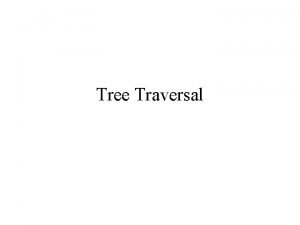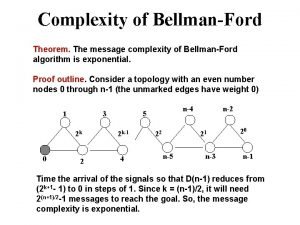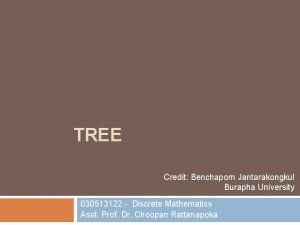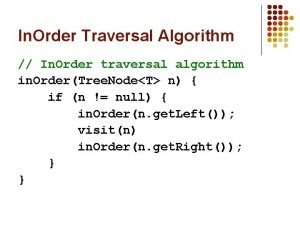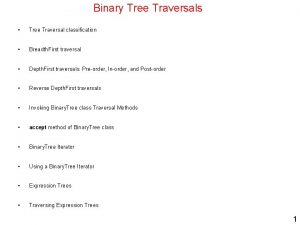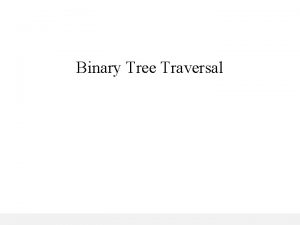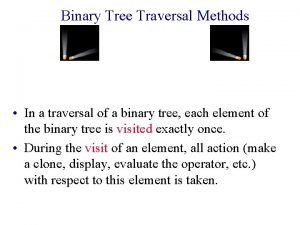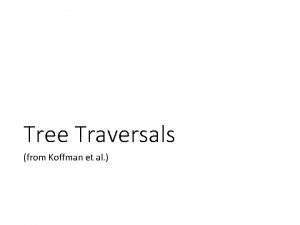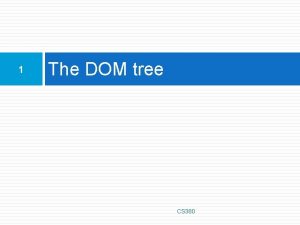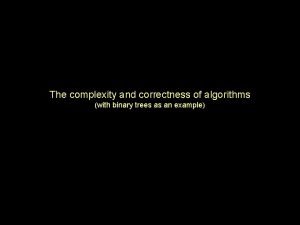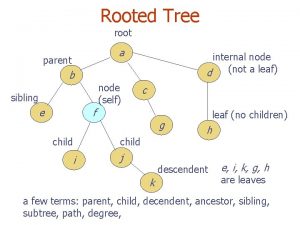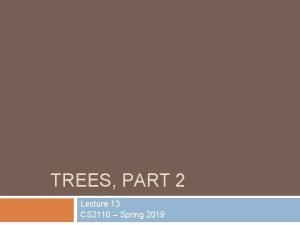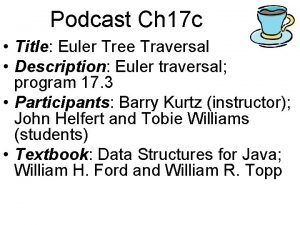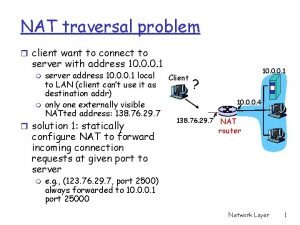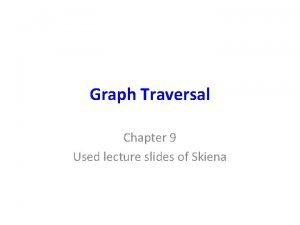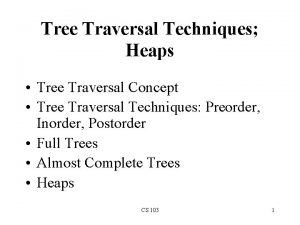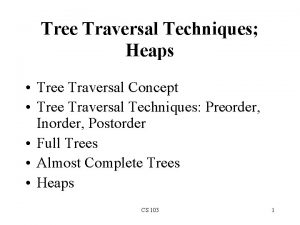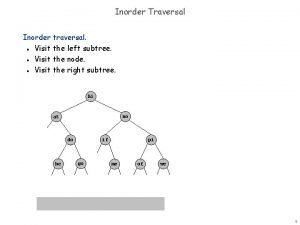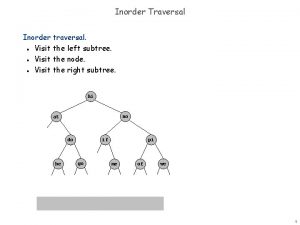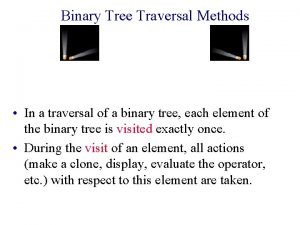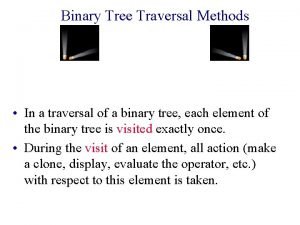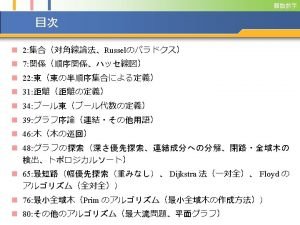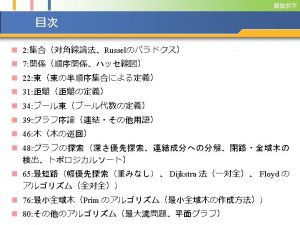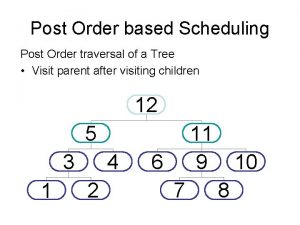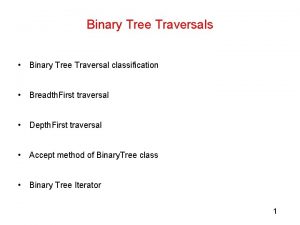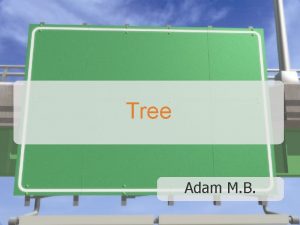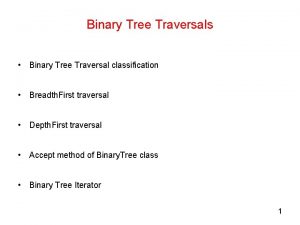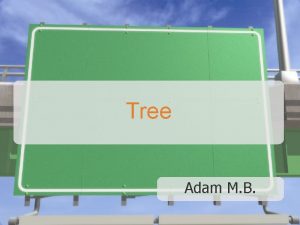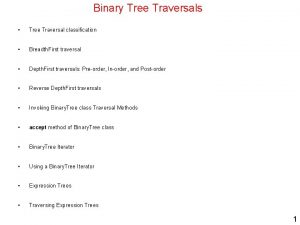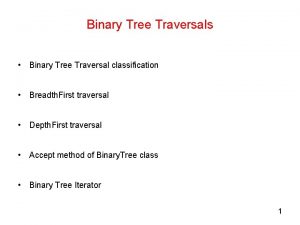Tree Traversal Pre Order Tree Traversal 1 Visit














![Reconstructing a binary tree Reconstruct. Tree (in. Order in[] pre. Order pre[]) if (n==0) Reconstructing a binary tree Reconstruct. Tree (in. Order in[] pre. Order pre[]) if (n==0)](https://slidetodoc.com/presentation_image/262dc2fb6c18d6a46553e7f6ff37e352/image-15.jpg)


![Reconstructing a binary tree Reconstruct. Tree (in. Order in[] post. Order post[]) if (n==0) Reconstructing a binary tree Reconstruct. Tree (in. Order in[] post. Order post[]) if (n==0)](https://slidetodoc.com/presentation_image/262dc2fb6c18d6a46553e7f6ff37e352/image-18.jpg)









- Slides: 27

Tree Traversal

Pre Order Tree Traversal 1. Visit the root 2. Traverse the left sub-tree, 3. Traverse the right sub-tree

In Order Tree Traversal 1. Traverse the left sub-tree, 2. Visit the root 3. Traverse the right sub-tree

Post Order Tree Traversal 1. Traverse the left sub-tree, 2. Traverse the right sub-tree 3. Visit the root

Post Order Tree Traversal • A*(((B+C)*(D*E))+F) • A B C + D E * * F + *

Tree Traversal

Example • Print the pre, in and post order form of the following tree H DAICBHEGF – in HBDIACEFG – pre ACIDBGFEH – post E B F D I A G C

Example class Node { private Object value; private Node left, right; public Node (Object value) { this. value = value; }. . . }

Example class Tree { private Node root; public Tree () { root = null; } . . . }

In Order traversal public void in. Order () { in. Order (root); } private void in. Order (Node current) { if (current != null) { in. Order(current. get. Left()); visit(current); in. Order(current. get. Right()); } }

Pre Order traversal public void pre. Order () { pre. Order (root); } private void pre. Order (Node current) { if (current != null) { visit(current); pre. Order(current. get. Left()); pre. Order(current. get. Right()); } }

Post Order traversal public void post. Order () { post. Order (root); } private void post. Order (Node current) { if (current != null) { post. Order(current. get. Left()); post. Order(current. get. Right()); visit(current); } }

Example • Can we reconstruct a tree from it’s In. Order traversal ? • Are there two different trees with the same In. Order traversal D • What about pre and post order ? A

Example • Can we reconstruct a tree given both it’s in order and pre order traversals ? in order - DAICBHEGF pre order - HBDIACEFG (find the root) Left sub tree DAICB BDIAC Right sub tree EGF EFG
![Reconstructing a binary tree Reconstruct Tree in Order in pre Order pre if n0 Reconstructing a binary tree Reconstruct. Tree (in. Order in[] pre. Order pre[]) if (n==0)](https://slidetodoc.com/presentation_image/262dc2fb6c18d6a46553e7f6ff37e352/image-15.jpg)
Reconstructing a binary tree Reconstruct. Tree (in. Order in[] pre. Order pre[]) if (n==0) return null root (T) pre[1] find index i s. t in[i] = pre[1] left(T) Reconstruct (in[1…i-1], pre [2…i]) right(T) Reconstruct (in[i+1. . n], pre [i+1…n]) return T

Reconstructing a binary tree • Time complexity • This is the same recurrence relation of quick sort

Binary Search Trees • In a BST the in order output is a sorted list of the tree nodes. • If we obtain a pre order path of a BST, we can sort the nodes and use the output to reconstruct the tree using the previous algorithm
![Reconstructing a binary tree Reconstruct Tree in Order in post Order post if n0 Reconstructing a binary tree Reconstruct. Tree (in. Order in[] post. Order post[]) if (n==0)](https://slidetodoc.com/presentation_image/262dc2fb6c18d6a46553e7f6ff37e352/image-18.jpg)
Reconstructing a binary tree Reconstruct. Tree (in. Order in[] post. Order post[]) if (n==0) return null root (T) post[n] find index i s. t in[i] = post[n] left(T) Reconstruct (in[1…i-1], post [1…i-1]) right(T) Reconstruct (in[i+1. . n], post[i…n-1]) return T

Level traversal (BFS) public void BFS () { Queue q = new Queue (); if {root != null) q. enqueue (root); while (! q. is. Empty()) { Node current = (Node)queue. dequeue(); visit (current); if (current. get. Left() != null) q. enqueue(current. get. Left()); if (current. get. Right() != null) q. enqueue(current. get. Right()); } }

Depth private int depth (Node node) { if (current == null) { return 0; } else { return Math. max(depth(node. get. Left()), depth(node. get. Right())) + 1; } }

private void print. Level (Node current, int level) { if (current != null) { if (level == 0) { visit (current); } } else { print. Level (current. get. Left(), level - 1); print. Level (current. get. Right(), level - 1); } } public void print. All. Levels () { int depth = depth (root); for (int i = 0; i < depth; i++); print. Level(root, i); } }

Questions • 1. Draw a single Binary Tree such that each node contains a single character and: – a. The pre-order traversal results in EXAMFUN – b. The in-order traversal results in MAFXUEN

Questions • 2. An in-order traversal of a Binary search tree yields a sorted list of elements in O(n) time. Does this fact contradict our comparison-based lower bound of nlogn time? Can something similar be done using a binary heap?

Questions • 3. Is there a heap T storing seven distinct elements such that a preorder traversal of T yields the elements of T in sorted order? • How about an in-order traversal? • How about a post-order traversal to yield the elements in reverse sorted order?

Questions • 4. Let T be a binary search tree with more than a single node. Is it possible that the preorder traversal of T visits the nodes in the same order as the post-order traversal of T? • If so, give an example; otherwise, argue why this cannot occur. Likewise, is it possible that the preorder traversal of T visits the nodes in the reverse order of the post-order traversal of T? • If so, give an example; otherwise, argue why this cannot occur.

Questions • 5. Given the following binary tree, print out the order of the nodes for an in-order traversal, preorder traversal, and post-order traversal. / / - * / / 2 a ^ * / b 2 * c / 4 a (division operator)

Questions • 6. Write a method that given a Tree. Node N , returned the number of elements contained at the tree rooted by N.
 Pre order
Pre order Pre order traversal
Pre order traversal Complexity of bellman ford
Complexity of bellman ford Post order traversal
Post order traversal In order traversal
In order traversal Via optica
Via optica Reverse binary tree
Reverse binary tree Which of the following tree traversal holds for clr
Which of the following tree traversal holds for clr Binary tree traversal techniques
Binary tree traversal techniques Huffman tree visualization
Huffman tree visualization Tree traversal visualization
Tree traversal visualization Dom tree
Dom tree Graph traversal in data structure
Graph traversal in data structure Tree traversal
Tree traversal Tree traversal in data structure
Tree traversal in data structure Explain about threaded binary tree
Explain about threaded binary tree Cyclomatic complexity of binary search
Cyclomatic complexity of binary search Root node
Root node Recover a tree from preorder traversal
Recover a tree from preorder traversal Bfs in discrete mathematics
Bfs in discrete mathematics Osnowa dokumentu
Osnowa dokumentu Traversal wave
Traversal wave Graph traversal in data structure
Graph traversal in data structure Euler tour traversal
Euler tour traversal Nat traversal problem solution
Nat traversal problem solution Iterative inorder traversal
Iterative inorder traversal Graph traversal methods
Graph traversal methods Understanding the efficiency of ray traversal on gpus
Understanding the efficiency of ray traversal on gpus
